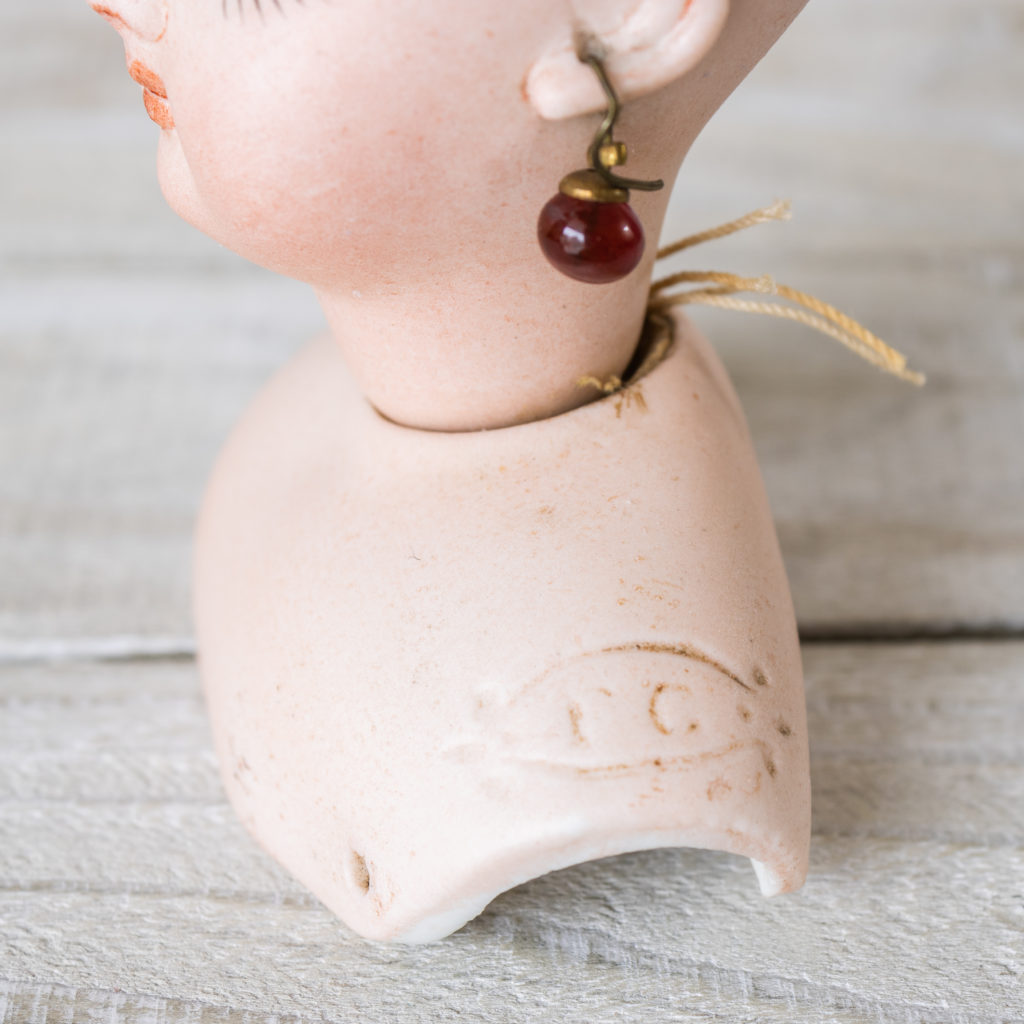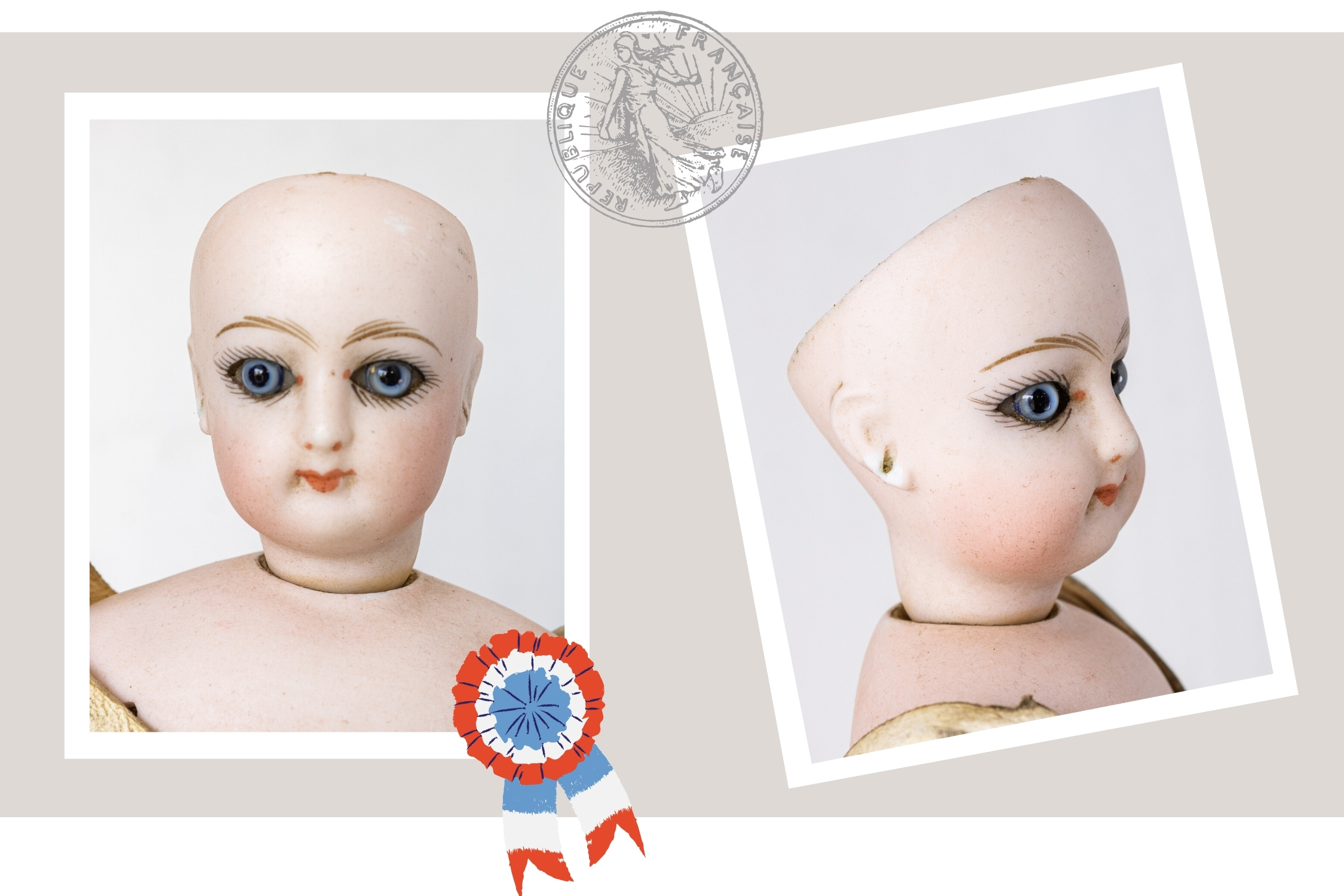Francois Gaultier made porcelain doll heads and busts for numerous manufacturers in Paris during the late 1800s. The Gaultiers also manufactured porcelain mannequin heads intended for the displays of hairdressers, milliners, “haberdashers”, tailors, grocers, and novelty shops. Archived records sometimes show his name spelled GAUTHIER.
The Gaultier house was founded in 1860 under the name “Gaultier and Pilorgé” with an address of
rue des Carrières, 34 and 92, in Charenton. The founder, Francois Gaultier, became the sole head in 1865, transferring the address to Saint-Maurice in 1867.
St. Maurice, a Suburb of Paris
The Gaultier family ran a very Parisian industry located in Saint-Maurice, a suburb of Paris. The location contributed to the success because of the available land and premises suited for industrial operations. The Gaultiers then could offer their porcelain doll heads at lower prices than manufacturers located inside of Paris.
Francois Gaultier and Eldest Son
In 1882 Francois Gaultier included his eldest son, Eugene Louis. Gaultier called the new company “Gaultier and Eldest Son” or “Gaultier et Fils Aine.” An 1883 publication announced the formation of the company name “Gaultier et fils aine” (Gaultier and older son) in the French Commercial Archives or “Archives commerciales de la France.”
The same year the formation of Gaultier et Fils Aine is announced, their listing describes the company as manufacturers of porcelain articles with an address at 19, rue des Epinettes, Saint-Maurice (Seine). (Journal des sociétés civiles et commerciales, 1883, p. 4) Bringing in his son allowed Francois Gaultier to have more freedoms to move into community roles in Saint-Maurice.
A listing in 1884 advertises that the Gaultier company was first founded in 1860 and had one medals in Paris in 1878 and Brusselles in 1880; manufacturing doll heads and porcelaine baby dolls in St. Maurice.
Gaultier Brothers, Gaultier Freres
In February 1888 the Gaultiers announce a modification to the “Gaultier et Fils Aine” company name in the Commerical Archives of France. It would from then be known as the Gaultier Brothers or “Gaultier Freres.” The announcement tells how Emile-Jules Gaultier will replace his father, Francois Gaultier, who had become mayor of Saint-Maurice two years earlier in 1886. Although ownership of the company transferred to his sons, people still considered Francois as the soul of the company.
In 1888 the Gaultiers announced the modification of their company name to “Gaultier Freres.”
1906 Publication of the F.G. Mark
One can find the F. G. mark in the scroll published in “the History of French Porcelain Manufacturers” by Chavagnac, Xavier-Roger-Marie de and Grollier, Gaston-Antoine, 1906. (See Gallica.bnf.fr or the online library for the Smithsonian here.)
Gaultiers Praised for Superior Work
People of Paris considered the work done by the Gaultiers to have delicate and brilliant qualities. The doll heads showed a skill of perfection, refined taste, and a true artistic sense, all of which were prerogative of Parisian manufacturers. The Gaultier factory or workshop employed skillful artisans to contribute to the charm and elegance of the dolls manufactured. A publication in 1894 claimed that anyone who visited the workshop would see these skilled specialists and have no doubt of the Gaultier’s superior work.
It was boasted that German manufacturers could not compete with the artistic work done by the Gaultiers.
“We find here the artistic character which is the glory of French industry, is that in this production Germany cannot compete with us when it comes to rich article: its types, heavy and without cachet, cannot even bear comparison for a moment. It is true that the German manufacturers compete with us fiercely as far as the low-priced, so-called bazaar, junk article is concerned. They have the advantage over us of much cheaper labor. But today some of our manufacturers have managed, by perfecting their tools and their processes, to support the fight even on this ground, and we have the satisfaction of being able to point out the Gaultier brothers house as one of those which fight most vigorously against the German competition.”
(a rough translation from Le Panthéon de l’Industrie : Journal Hebdomadaire Illustré, Dec. 1894, p. 211)
The Gaultier’s Award Winning Workmanship
The Gaultiers won medals at various European exhibitions: a bronze medal in Brussels in 1880, silver medals in Paris in 1878, Amsterdam in 1883, Nice in 1884, Antwerp in 1885, and in Paris in 1889.
The announcement of the silver medal won in 1883 in Amsterdam appeared in various publications such as the “Rapport sur l’exposition internationale industrielle d’Amsterdam en 1883 : adressé à M. le ministre du Commerce” (p. 310) and the “Journal officiel de la République française” (p. 85). Interestingly the medal came from a category for furniture and furniture accessories, not for dolls.
At the Universal Exposition in Paris in 1889 the silver medal won in Paris by Gaultier et fils aine did represent the category for French Toys. (Le Jouet Français : Bulletin Mensuel : Organe de la Chambre Syndicale des Fabricants de Jouets et Jeux, May 1889, p. 149)

Francois Gaultier, Mayor of St. Maurice
F. Gaultier served as mayor of St. Maurice from 1886 to 1902. A publication called “Le Panthéon de l’industrie : journal hebdomadaire illustré” wrote about Francois Gaultier’s rise from a simple porcelain worker to the high position of mayor of Saint-Maurice. The writer of the story explains that the residents elected Francois Gaultier as municipal councillor, later deputy mayor, and finally mayor, although the Saint-Maurice town records use the Gauthier spelling. (see also here)
A French newspaper mentions that F. Gaultier, the mayor of St-Maurice, spoke at a funeral service for a wagon driver or carter named Quêzou or Guezou who died due to injuries suffered in the factory explosion in Joinville-le-Pont. In this publication the writer uses the GAULTIER spelling.
While mayor he attended a banquet celebrating the victory for M. Baulard, an elected republican official. The banquet held in 1893 occurred in a restaurant Bonvalet at Boulevard du Temple. Many of Baulard’s political colleagues attended. Here, the writer uses the GAUTHIER spelling.
Francois Gaultier, a Hero of French Industry
Francois Gaultier was described as well known for his modesty but praised for the undeniable superiority and remarkable organization of the Gaultier Brothers manufacturing house who was entirely worthy of its success.
During this time France felt the challenges of maintaining competitive industry next to Germany’s rapid rise in the 1890s. A writer contributed a hero of France like character to Francois Gaultier in light of this national economic struggle:
After the services he has rendered to national industry in the fight against German competition, after the various services rendered to his commune which he has shown for a long time, this distinction, so honorable moreover, perhaps does not answer not quite what he deserves, and we expect to see, in the near future, a change in the color of the ribbon he wears in his buttonhole.
Le Panthéon de l’industrie : journal hebdomadaire illustré, 1894 Dec., p. 211
1899 Joining with SFBJ
Beginning in 1899 Eugene Louis Gaultier of Gaultier Brothers served on the board of the newly formed SFBJ trade union. Eugene Louis Gaultier served in this role along with Salomon Fleischmann, Emile-Louis Jumeau, Edmond Lefevre, and Adolphe Schnerb. He is described as a merchant or wholesaler of Saint-Maurice (Seine). The SFBJ stood for “Societe Francaise de Fabrication de Bebes et Jouets.” Or in easier to understand words: the French Union (company) of the Manufacturing of Dolls and Toys.
The Gaultier brothers brought to the new SFBJ their business located in Saint Maurice (Seine) at the address of Rue des Epinettes n.25. With that business they agreed to bring their clientele, their goodwill, all trademarks and patents, models, materials, and tools. This included machinery and movable objects in the factory. All these things the Gaultiers guaranteed sincere and genuine.
The brothers appear in SFBJ meeting minutes in 1906 where the minutes list Emile as an administrator and Eugene as present, both as active shareholders. The minutes begin on page 3342 of the “Bulletine Municipal Officiel de la Ville de Paris” dated October 6, 1906. The company has a capital listed at 4,180,000 francs.
